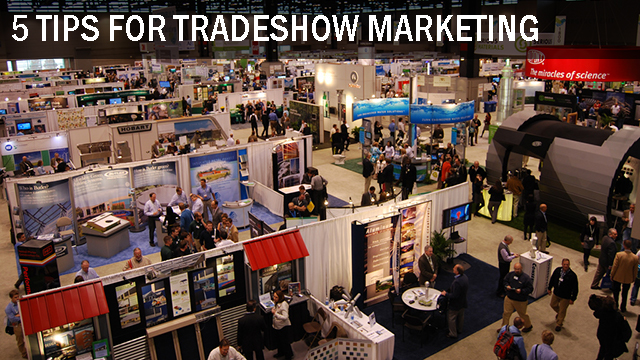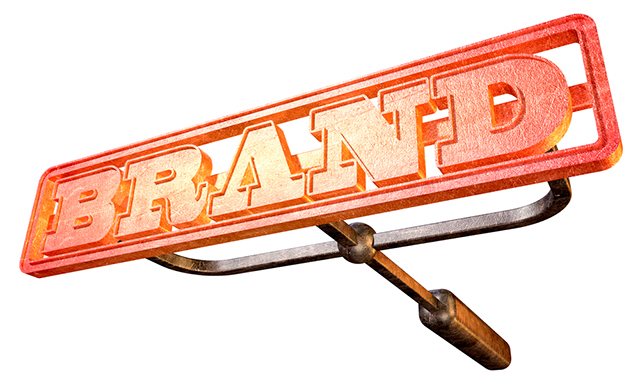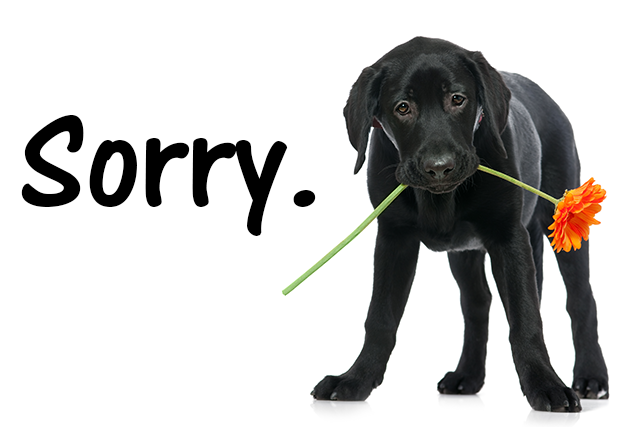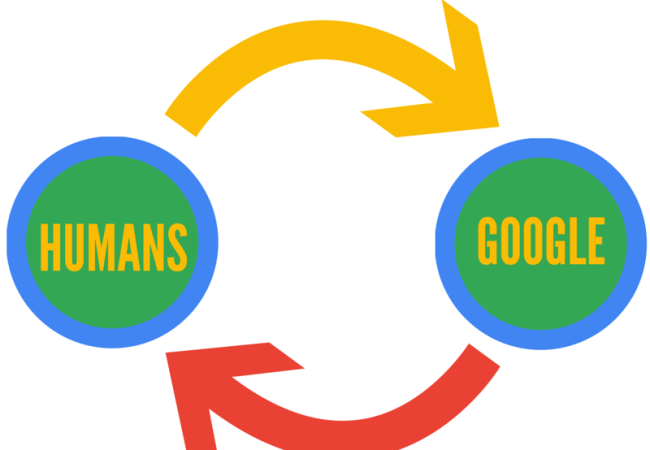I remember in a job interview, a future boss and…

5 Tips for Tradeshow Marketing
This week, I’ve been hanging out of a tradeshow. I love tradeshows when they work. Where else can a large group of primed and ready prospects be delivered to your door? I took a moment of down time to walk through the exhibit hall and see what the other vendors were up to. There were some great booths, but overall, there was a lot to be desired. Many booths even left me wondering what they were actually selling. Wow… they invested thousands of dollars in time and material and we’re not sure what they sell???? Here are some tips to think about when planning your tradeshow booth.
Define what you want to communicate
While walking the exhibit floor, one booth that I saw had the company’s logo on top and then a long list of maybe fifty or so services that the company offered. Maybe the point was to show what a wide variety of services they offer, but the point I took away was that I didn’t have time to read it all, so I moved on. You have just a few seconds to get folks attention (see the section on “Break Your Booth into Thirds”).
Define who to attract (and who to repel)
Most conferences have segments that are more or less interested in what you have to sell. Maybe it’s a banker’s convention with financial wizards, IT geeks and marketing gurus. Or maybe a construction conference where there are different types of contractors, or maybe even folks from the construction design community. There are people that you want at your booth, but there are also people you don’t want at your booth. I would go so far as to say, you want to repel them from your booth.
Let me give you an example. A few years ago I was at my booth talking with a wealthy and successful business owner. He had very direct and thoughtful questions about the product I was selling. Twice while having this high dollar conversation, I was interrupted by conference goers wanting me to punch their booth tour card so they could be entered into a raffle. Those raffles seem like a good idea, right? A few exhibitors complained one year that nobody came to see them, so the conference organizers developed a booth bingo card of sorts to encourage booth traffic. The next year, folks noticed an uptick in booth traffic. Mission accomplished, right? Nope. I want to increase profitable traffic and decrease unprofitable traffic.
In the quest to get or repel attention, what is the message that says, “this is for you, but not for you” in seconds? Is it your logo? Maybe… certainly Microsoft across the top of the booth attracts the tech folks, but send the marketing folks running for the hills. Maybe that’s a good thing. Unless, the main thing you want to sell at your booth is the Microsoft Dynamics CRM software package intended for marketing and sales teams. In one case leading with the logo was good, in another case it was bad. In both cases, the name Microsoft carried with it great meaning in the customer’s mind before the ever set foot in the exhibit hall.
Break Your Booth into Thirds
As I said, you don’t have much time to get, or repel attention. I would strongly encourage you to sneak into an exhibit hall somewhere for an industry you know nothing about. Watch how people walk the floor. It’s very informative. They walk in a slower than normal pace, with their eyes up and scanning for something to get them to stop. If they don’t see it, the pace keeps them moving. You have just about three to eight seconds to get them to stop. If they stop, or slow their pace, they will begin to look down and see if there is more. That’s your moment do ask a question and start a conversation.
There are those that are looking down, but they are often the looking for a free pen (see the section on “No Giveaways”).
In Steve Miller’s book (not that Steve Miller, THAT Steve Miller), How to Get the Most Out of Trade Shows, he talks about breaking the booth design down into thirds. The top section is your main point, the middle is education, and the bottom is for corporate identity (they call it branding, but the whole booth should contribute to branding).
This fits well into the observations of people’s eye and body movement as the move through the convention hall. The funny thing is, it is almost the opposite of how the tradeshow community designs their booths.
No Giveaways
I remember one time, I left my booth during a quiet spell. I had a bowl of candy out on the table. As I returned there was a gentleman approaching the booth. He sauntered up to the table, quickly glanced around at the brochures, and then made his move. With one fluid motion and with lightening reflexes betrayed by his silver hair and hunched posture, he reached into the bowl, grabbed half of the contents and deposited his treasure into his pocket. I have to admit, it was smooth. Maybe, if I had been there, he would have passed me by. More than likely, he would have tied up my time making small talk and taken a fraction of the score. We both would have left the interaction sorely disappointed.
For most tradeshows, the product we’re selling is not small. I don’t think a breath mint will make the sale (unless you are in the breath mint business, then it better make the sale). Often, the most popular giveway is a bag with the company’s logo on it. Surely, there is some value in that bag reminding the potential customer of your brand (see my article on brand) for years to come, right? Unfortunately the bags are often most attractive to the crowd that wants to fill them with pens.
The exception is something high dollar that you can hold in your hand. Instead of giving away 500 pieces of fifty cent land fill material, invest in twenty-five $5 items that have some real staying power. Rather than keep whatever it is out on the table, only keep one out at a time and hold it in your hand. After a fruitful conversation, offer it as a gift along with some other “gifts” like a business card and a brochure.
Let’s talk about business cards while we’re at it. It’s not always possible, but when you give a business card away, personalize it in some way. For example, write the specific product name on the back, maybe write your cell phone number letting them know that they have special access to you, or write down the next step in the sales process (see the next section).
What about raffles and contests? Isn’t that a great way to get leads to follow-up on after the show? I remember one consumer show I did several years ago. The show started at 4pm before folks could get out of work. We had a raffle on a prime rate personal loan (a big deal with interest rates at the time). Well, right at 4pm, a bus from retirement home pulled up. These people were professional raffle enterers. They used the free address labels companies will send out and stuck them on raffle entries to enter a contest for a product that they didn’t want or need. I had intentions of calling every name in the box for follow-up, but as soon as I saw that the box was stuffed with names from folks that were not in my target market, I knew I’d just toss them all after picking a winner.
With many tradeshows and products, one good sale can pay for the whole thing. If that’s the case, I’d rather walk away with a small list of five good contacts than a box of 1,000 not so good contacts that will talk me hours to wade through… even if it means missing a good lead or two.
Again, remember what I alluded to before, if somebody is walking the show with their eyes down, they are not looking to buy, they are looking to get freebies. Be attractive to the folks with their eyes up.
Your booth should stand on its own to attract your customers. Any attempts to use gimmicks like giveaways or raffles mask the fact that your underlying booth just isn’t getting the job done.
Ask for the Next Step and not the Sale
As I mentioned, usually tradeshows are about a bigger sale. Even if you are selling something cheap, chances are you need to sell them in a big way to justify the costs of the show. Most buyers are in search mode and are not prepared to buy on the spot. It should be clearly defined for you what the next step in the sales process is and that is the commitment to set with the potential customer. The number of commitments to go to the next step in the sales process is your best initial indication of show success. “That’s interesting and I’ll have to call you about that,” sounds like a great conclusion to a conversation, but in fact it’s a horrible end and temporary warm fuzzies fade into nothing.
Track and Follow-up
If the initial measure of success is the commitments to the take the next step, then by all means… measure it. How many contacts did I have? How can I segment them? How many took the next step? Every interaction, should be recorded. If the show is rich with contacts, but not with commitments to the next step, maybe your booth is attractive the wrong people, or maybe some sales training is needed to ask for the commitment for the next step. Either way, tracking will tell you a lot.
Follow-up is where things seem to often fall apart. “The show was great, but I don’t think that we sold anything,” is a sign that we missed opportunities. The first step in having good follow-up is having a way to follow-up (see the previous section). After that, we need to actually do the work and make the calls and continue onto the next step in the buying process.
Not all these tips apply to all situations, but hopefully there are a few ideas you can use to make your experience at your next tradeshow more fun and more profitable.


